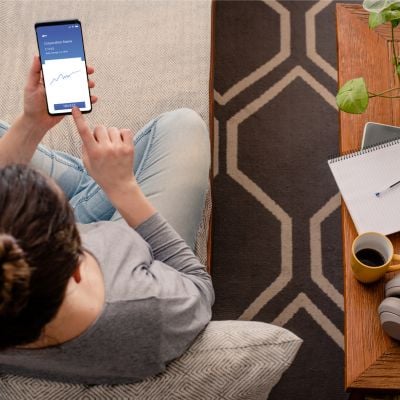HELOCs are a type of revolving, secured loans

HELOCs are a great borrowing tool for homeowners to tap into their home’s equity. There’s nothing wrong with taking one out — in fact, if borrowers are confident they’ll only borrow what they can afford to pay back, they’d be hard-pressed to find better interest rates with another type of loan.
One great thing about HELOCs is that you can take one out without ever using it. They work a lot like credit cards, which are another form of revolving credit. And like credit cards, borrowers only pay interest on the amount of credit they use. For that matter, there are even free online services that allow you to compare HELOC loans available to you for no cost.
Here’s how it works: Homeowners can borrow up to 65% of their home’s purchase price. But how much money individuals are able to access depends on the amount of equity they have.
Together, what you still owe on your mortgage and your HELOC combined cannot exceed more than 80% of your home’s value.
Say you borrowed $450,000 to buy your home and it’s now worth $500,000. You still owe a balance of $300,000, which means there’s $200,000 in equity on the home.
That means you can theoretically borrow up to $292,500 (65% of your home’s purchase price). But since your mortgage and HELOC combined can’t amount to more than 80% of your home’s value, you’ll only have access to $100,000.
As you pay down your mortgage balance, you’ll gain access to more equity to borrow against. Other factors like your credit score will also impact how much you can borrow with a HELOC. If you don't know your credit score you can check it for free.
Maximize Your Tax Refund with TurboTax Canada!
Simplify tax season with this user-friendly software. Get step-by-step guidance, maximize deductions, and file with confidence. Trusted by millions, TurboTax Canada ensures accuracy and peace of mind. Start your taxes today and get the refund you deserve
Get the tax refund you deserveBorrowing with a HELOC can be risky — but it depends

Another great thing about HELOCs is that they don’t come with fixed repayments. However, interest will accumulate on what you borrow, until you repay the balance.
One risk is that HELOCs generally come with variable interest rates. Which means that when rates go up, borrowers’ monthly payments could significantly increase.
Inflation is on the rise, which could lead the Bank of Canada to raising interest rates sooner than expected — some speculate that could come as soon as early 2022.
There’s another factor at play here that could make HELOCs a risky financial move for some: Home values have been skyrocketing this past year.
That can lead to some homeowners borrowing like that trend will never end. But when it inevitably does, they may find themselves seriously in the hole.
And because their homes are put up as collateral, it’s more than just their wealth that’s on the line.
How to tell if you’ve taken on too much debt

If interest rates rise suddenly, families with large mortgage payments and other debt could quickly find themselves overleveraged.
“In 2018 when interest rates went up, we saw a drop in credit card payments, especially among consumers with a HELOC. It also led to higher bankruptcies among older consumers with HELOCs,” said Rebecca Oakes, AVP of Advanced Analytics at Equifax Canada, in a statement.
And the banks will likely adjust their rates within hours or days of the central bank making an announcement about a rate change.
What does that look like? National Bank’s interest rates on HELOCs are prime (the interest rate major banks charge their customers) plus one. As prime is currently 2.45%, your loan will come with a 3.45% interest rate.
The Bank of Canada is expected to raise rates by 0.5% as soon as April 2022. That would bump your interest up to 3.95%.
If you withdraw $30,000 from your HELOC to pay for a home renovation project that you intend to repay over three years, you’ll be paying an extra $7 just in interest every month.
That may not sound like much, but it amounts to an extra $84 a year. If your budget is already stretched, it can make it easy to fall behind on payments.
Grow Your Savings Effortlessly with Moka
Automate your savings with every purchase and watch your money multiply. Moka rounds up your transactions and invests the spare change. Start building wealth effortlessly today. Join thousands of Canadians embracing financial freedom with Moka
Sign up nowHow to decide whether a HELOC is right for you

Whether you should take out a personal loan or HELOC depends on a few factors.
If you earn a steady income and you need a set amount of money, like say for a home renovation project, a personal loan may be your best option. You’ll have set payments with a fixed interest rate and always know what you owe each month. There’s something to be said for that certainty.
But if you might need money for an emergency someday down the road, a HELOC could be right for you. It's free to see quotes for the best HELOC opportunities available to you
If you’re looking into borrowing options, there are a few things the Financial Consumer Agency of Canada advises borrowers do when it looks like interest rates may go up.
- Make sure you have an emergency fund set up.Cut your expenses so you have more money on hand to tackle debt.
- Only borrow what you can afford to repay, which is often a fraction of the amount you’re able to borrow.
- Consider whether taking on more debt gets in the way of your savings goals and make sure you have a high-interest savings account.
- Find ways to earn a little extra income — potentially by taking on a profitable side hustle.
- Address your debts with the highest interest rates first — potentially by consolidating them in a personal loan at a lower interest rate.
Sponsored
Trade Smarter, Today
With CIBC Investor's Edge, kick-start your portfolio with 100 free trades and up to $4,500 cash back.







